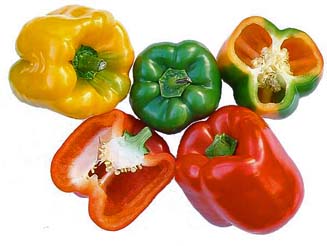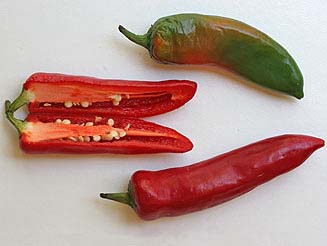Capsicum annuum
(Sweet pepper, Chilli pepper, Cayenne pepper and Paprika)
Life
> eukaryotes >
Archaeoplastida >
Chloroplastida
>
Charophyta > Streptophytina > Plantae (land plants)
> Tracheophyta (vascular plants) > Euphyllophyta > Lignophyta (woody plants)
> Spermatophyta (seed plants) > Angiospermae (flowering
plants) > Eudicotyledons > Core Eudicots > Asterids
> Euasterid I > Order: Solanales > Family: Solanaceae
 |
 |
|
Sweet peppers. [photo H. Robertson, Iziko
©] |
Chilli peppers. [photo H. Robertson, Iziko
©] |
Peppers orginate from Central America where most of the
main varieties were developed by local Indians. Once peppers were discovered by
the Spaniards and Portuguese they were rapidly introduced worldwide and eagerly
incorporated into local cuisines. Sweet peppers can be eaten raw or cooked;
chilli or hot pepper are used in seasoning.
The wild form of this species is native from Florida and the Bahamas to
Arizona and down though Central America to Colombia. Seeds have been found in
archaeological excavations dating to before 5000 BC in the Tehuacan Caves at
Puebla, Mexico. Evidence suggests that by 3500 BC, Capsicum annuum was under
cultivation.
Other species of Capsicum are also grown (e.g.
Capsicum frutescens is
the main ingredient of Tabasco sauce) but Capsicum annuum has produced almost
all the varieties of chillies and peppers. Capsicum annuum is an
annual species whereas Capsicum frutescens is a perennial. Varieties can be either sweet
or hot and come in a variety of colours. The green pepper is an unripe red or
yellow sweet pepper. The spice paprika is also derived from varieities
of Capsicum annuum and is used in cooking (e.g. egg, cheese and potato
dishes).
The hot flavour of chilies is caused by the substance capsicin which is
concentrated mainly in the placenta (i.e. the connective tissue between the
fruit and the seeds) and the seeds. A single mutation of a particular gene turns
off capsacin production to produce a sweet pepper.
Capsicum species were brought back to Europe by the Spaniards in the late
1400's and early 1500's and soon became enormously popular as they could be
easily grown in gardens and could be used as a replacement spice for
Pepper Piper nigrum which was very expensive. Chili peppers were probably
introduced to Africa and Asia by the Portuguese and in Asia in particular,
became widely grown and incorporated extensively into local cuisine.
Many of the varieties of Capsicum annuum were developed by New World Indians
before European invaders arrived. Modern breeding has tended to concentrate on
developing new sweet pepper cultivars.
Peppers have high levels of Vitamins A and C.
References
-
Sauer, J.D. 1993. Historical geography of crop plants - a select roster.
CRC Press, Boca Raton, Florida.
-
van Wyk, B.-E. 2005. Food Plants of the World -
Identification, Culinary Uses and Nutritional Value. Briza, Pretoria.
Text by Hamish Robertson |
